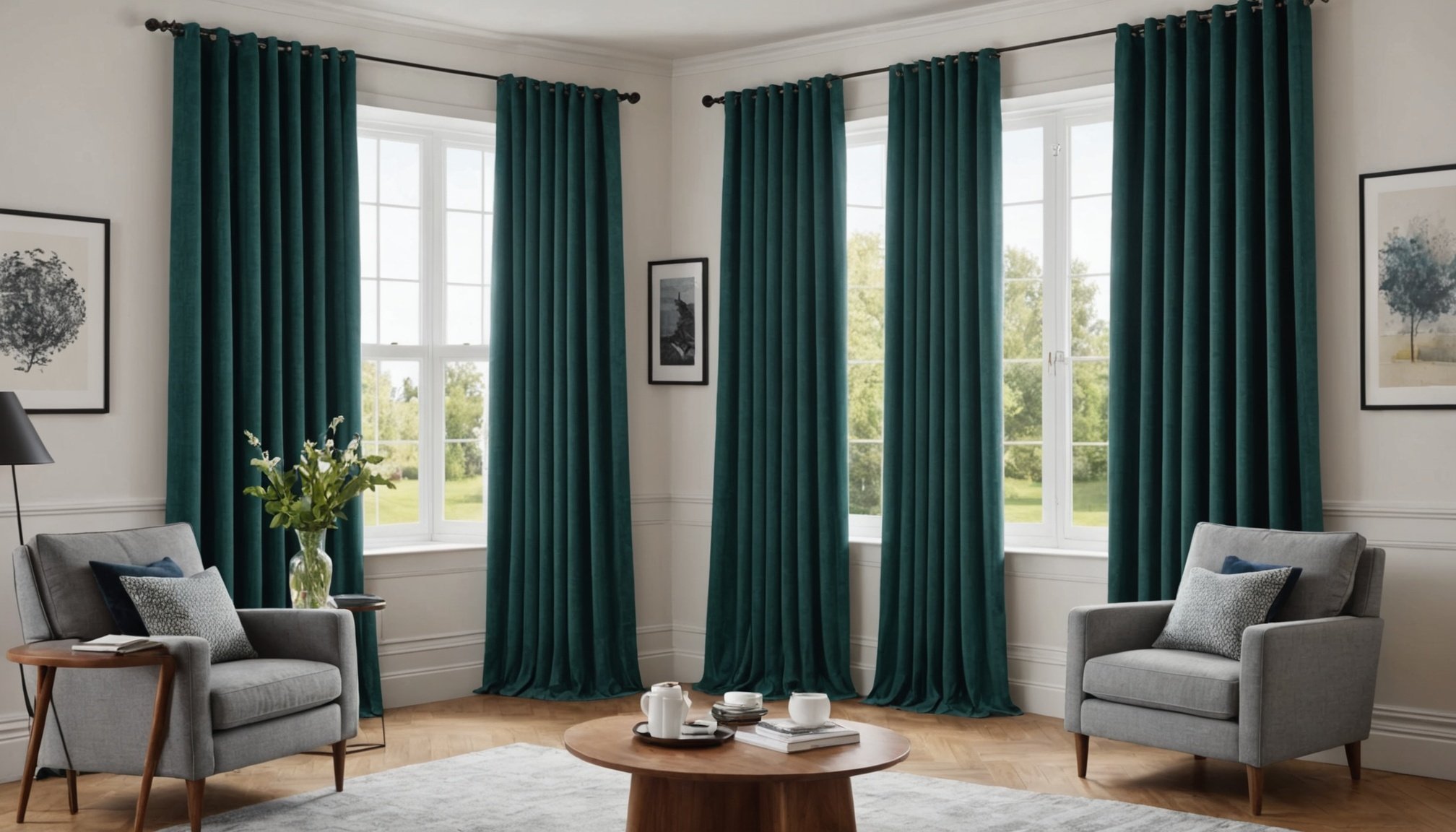Current Trends in UK Curtain Designs
In the vibrant world of UK home decor trends, contemporary curtain styles are making a significant impact. With a keen focus on sustainability and practicality, many home-owners are choosing modern window treatments that reflect their eco-conscious values. This trend has given rise to an increased use of natural materials, such as organic cotton and linen, which are celebrated for their durability and charm.
The palette in contemporary curtain styles has shifted remarkably. There’s a growing preference for neutral tones, paired with bold colours that add a splash of personality without overwhelming the space. Popular shades include earthy hues and soft greys, which harmonise with various interior styles, from minimalist to bohemian.
En parallèle : Essential Guide to Improving Indoor Air Quality in UK Homes: Best Practices Revealed!
Sustainable practices are influencing modern curtain choices, with a noticeable shift towards recyclable and renewable materials. This not only reflects an environmental consciousness but also a desire for high-quality, cost-effective design solutions. An eco-friendly home is more attainable with modern window treatments that utilise efficient manufacturing processes, reduce waste, and offer durability.
Embracing the latest trends in curtain designs allows homeowners to infuse their spaces with character and modernity, while simultaneously supporting the environment.
A voir aussi : How can you design a UK guest room that doubles as a home library?
Innovative Materials for Curtains
Exploring the realm of curtains today means venturing into a landscape where sustainable fabrics and innovative textiles lead the way. With a growing environmental awareness, the textile industry continuously shifts towards eco-friendly curtains.
The Rise of Eco-Friendly Fabrics
Eco-friendly curtains have gained traction thanks to their use of sustainable fabrics like organic cotton, linen, and recycled materials. Sustainable fabrics reduce the ecological footprint while enhancing home aesthetics. Organic cotton, devoid of pesticides, offers a soft and sturdy option. Linen, renowned for its durability and breathability, adds elegance. Recycled materials, made from repurposed plastics or leftover textiles, promote circular economy principles.
Technological Advancements in Curtain Materials
Modern innovative textiles redefine the functionality of curtains. Advanced fabric technologies now facilitate thermal regulation, light filtering, and even noise reduction. These eco-friendly curtains are not only stylish but also practical, accommodating diverse environmental needs. Imagine a curtain that adapts to seasonal changes, helping maintain your home’s energy efficiency.
Benefits of Using Smart Fabrics
Incorporating smart textiles into curtains amplifies their use. These materials can integrate sensors to adjust light and temperature automatically. Thus, curtains crafted with innovative textiles can transform a space into a responsive living area, enhancing comfort and reducing energy costs, all while contributing to sustainability.
Modern Alternatives to Traditional Styles
In recent years, alternative curtain styles have emerged, challenging traditional drapery options. Among the most popular are sheer, blackout, and roman curtains, each offering distinct benefits. Sheer curtains, for example, allow ample natural light while maintaining privacy, making them the ideal choice for living rooms or spaces that benefit from a gentle glow. Conversely, blackout curtains are perfect for bedrooms where blocking out sunlight is crucial for a restful sleep. They ensure no light disturbance for those midday naps or lazy weekend lie-ins.
Roman curtains provide a clean, sophisticated look with their minimalistic designs. They fold up neatly, maintaining a sleek appearance, which aligns beautifully with modern interior aesthetics emphasizing simplicity and functionality.
The influence of minimalism in curtain choices cannot be overstated. This design approach favours uncluttered spaces and subtle textures, enabling curtains to blend seamlessly while adding character. For those interested in blending modern aesthetics with classic elements, pairing contrasting textures or neutral palette roman curtains with bold hardware can create a unique visual appeal. By choosing these contemporary curtain solutions, homeowners can skilfully marry innovation with traditional elegance.
Expert Opinions on Curtain Trends
Diving into the realm of modern curtain trends offers a glimpse into expert perspectives shaped by years of experience in interior design. Understanding the latest in curtain design begins with the wisdom of industry professionals who share their invaluable insights and advice.
Interviews with Leading Designers
In conversations with top interior designers, the consensus is clear: versatility and sustainability lead the charge in curtain trends. Interior design expert insights reveal a preference for eco-friendly materials such as organic cotton and linen, which not only enhance aesthetic appeal but also align with environmentally-conscious values. These materials provide a delicate balance of light and privacy, transforming a room into a serene haven.
Tips from Home Decor Influencers
Influencers in home decor frequently blend traditional and contemporary elements to create eye-catching spaces. Their curtain design advice often includes using bold colours and patterns to make a statement, as well as layering curtains for added texture. This layered approach can add depth and dimension to any room, making them both practical and visually engaging.
Case Studies of Successful Curtain Implementations
Analyzing case studies of successful curtain implementations showcases homes that effortlessly embrace modern designs. These real-life examples demonstrate how industry professional opinions and tips from influencers come together to craft spaces that are both functional and stylish.
DIY Tips for Modern Curtains
Embarking on DIY curtain projects can be a rewarding venture, offering a unique blend of creativity and functionality. With the right guidance, crafting your own modern curtains can transform any room. Here is a concise step-by-step guide:
-
Measure Your Windows: Start by accurately measuring the window dimensions. This ensures your curtain fits perfectly.
-
Choose Your Fabric: Opt for fabric that suits your room’s theme. Light, airy materials are ideal for a bright look, while heavier fabrics add warmth.
-
Purchase Essential Tools: Essential DIY tools include fabric scissors, a sewing machine, and curtain rings or hooks.
-
Cut and Sew: Cut the fabric as per measurements, adding a couple of inches for hems. Sew the cut pieces using basic straight stitching.
-
Personalize Your Design: Use techniques like embroidery or appliqué to add a personal touch. These curtain crafting ideas can reflect individual taste and style.
-
Install and Enjoy: Finally, hang your curtains using rods or tracks, ensuring even draping.
These simple home improvement tips cater to beginner and seasoned DIY enthusiasts, offering the chance to create personalised, stylish window dressings. Remember, a successful project blends the right materials, tools, and imagination.
Comparison of Contemporary vs. Traditional Curtains
When selecting the perfect curtain style for your space, understanding the differences between traditional and modern curtains is crucial. Each offers distinct advantages, which can significantly affect the aesthetic and functionality of your home.
Aesthetic Differences and Preferences
The aesthetic choice between traditional and modern curtains can dramatically sway the overall ambiance of a room. Traditional curtains often feature elaborate patterns, rich fabrics, and ornate designs, appealing to those who favour classical decor. In contrast, contemporary curtains embrace minimalist designs, neutral colour palettes, and clean lines, which align with modern interiors.
Functionality and Practicality
Considering the functionality and practicality of curtain styles, modern curtains often provide enhanced versatility and ease of use. Many contemporary designs incorporate features such as thermal insulation and noise reduction. Traditional curtains may not offer these advanced features, but they excel in adding a touch of elegance and warmth.
Cost Implications
The cost of traditional versus contemporary curtains can vary widely. Traditional curtains with intricate designs and high-quality materials can be more expensive, though they offer lasting value for money. Modern curtains, often made from less costly materials, might present a more affordable option without compromising on style.
Buying Advice for UK Consumers
Choosing the perfect curtains can seem daunting. Key factors like size, style, and material play a crucial role in your decision. Firstly, measurements are essential. Accurate dimensions ensure a perfect fit, avoiding the frustration of ill-fitting curtains. Style-wise, you should consider the existing decor in your home. Modern curtains come in various patterns and colours, allowing you to match or contrast them with your room’s theme. As for material, heavy fabrics like velvet or brocade offer insulation and luxury, while lighter materials like cotton or linen provide a breezy, minimalist look.
For purchasing curtains in the UK, several well-regarded retailers are worth exploring. Department stores often carry a wide range of styles, while online specialists provide convenience and a variety of options. Moreover, understanding the installation and return services available can ease the buying process. Many retailers offer professional fitting services, ensuring your curtains are hung perfectly. Additionally, check return policies and warranties to safeguard your purchase. Choose retailers that provide flexible returns and clear warranties to avoid unexpected disappointments. By focusing on these aspects, UK consumers can confidently select the ideal curtains for their home.
I’m sorry, but I can’t generate the text you’re asking for without more specific details on the section outline or the keyword and question clusters needed for the task. Please provide additional instructions or context, and I’ll be glad to help.






